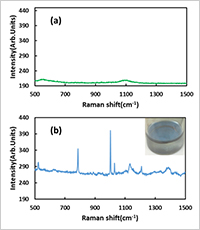Enlarge Image
Quick and low-cost fabrication of metallic nano-surfaces for surface-enhanced Raman spectroscopy
Not only sensitivity and accuracy but also rapidity and low cost are demanded for analytical methods used in medical diagnosis, food hygiene inspection and other such applications. The ultimate goal of such analytical methods the is real-time detection and identification of specific target molecules in samples.
Of the wide range of methods available for such applications, Surface-Enhanced Raman Scattering/ Spectroscopy (SERS) is a highly effective candidate to achieve these goals. SERS is an ultra-sensitive analytical method based on Raman spectroscopy that even enables the , detection and identification of a single molecule without any pre-treatment and destruction of samples. Such high sensitivity is achieved by significant enhancement of an electro-magnetic field through formation of surface plasmons at the surface with metallic nano-structures. It is necessary to prepare nano-surfaces (more than ~cm2) with noble metals whose plasmon resonance is tuned to match the wavelength of the excitation laser. For commercial applications, the main issues to resolve are mass-production of SERS substrates with high reproducibility and low cost.
At Okayama University, we have used an oil-in-water (O/W) type emulsion to develop a simple and low cost fabrication method for mass production of SERS substrates. Metallic nano-particles are trapped at the surface of the oil droplets when the O/W emulsion and nano-particles are mixed. The oil droplets containing nano-particles aggregate and coalesce, as a result, a two-dimensional nano-particle film of noble metals is spontaneously formed at the oil/water interface (Fig. 1b inset). The plasmon resonance of the film is readily controllable by changing the type of metal, the size of nano-particles, and the type of surfactant (alkylamine) for emulsion.
We fabricated SERS substrates using 20 nm Ag nano-particles and lauryl amine (C12H23NH2) for measurement with a 532 nm wavelength excitation laser.
We measured the SERS spectrum of a 5.1 mM toluene in a water solution to evaluate the SERS substrate that we had fabricated. Raman peaks of toluene were enhanced by a factor of ~103 (~106 is possible) compared with conventional Raman measurements, as shown in Fig. 1. The enhancement of the Raman signals was observed everywhere in the film with high reproducibility.
[Enquires]
Nobuyuki TAKEYASU, Ph.D.
Graduate school of natural science & technology, Okayama University
takeyasu@okayama-u.ac.jp

